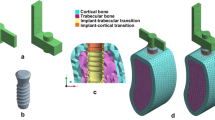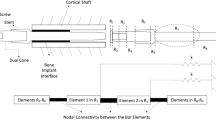Abstract
Osseointegration trans-femoral implants are a new orthopaedic anchoring method to attach prosthetic limbs. The clinical success of this promising technique depends on the effectiveness of osseointegration achieved after implantation. The aim of this study is to use the resonant characteristics of the implant system to determine the changes in stability as a reflection of boundary condition of the implant. With a small mechanical excitation, Vibration responses of the trans-femoral implant to a small mechanical excitation were measured using an accelerometer and the vibration signal was analyzed using Fast Fourier Transform (FFT) software to obtain the fundamental natural frequency (NF) of the implant system. In-vitro study was conducted using different silicone rubbers to simulate the interface condition. The result showed that a high NF corresponded to a high elastic modulus of the interface material between the implant and bone. A preliminary in-vivo study with one osseointegration trans-femoral implant patient showed that there was a decrease of NF after initial weight bearing rehabilitation. After continued weight bearing, the NF gradually returned to the pre-loading level at around day 24 and the general trend of the NF reached a stable state 38 days after the first weight bearing exercise.








Similar content being viewed by others
References
Albrektsson T., Jacobsson M. (1987) Bone-metal interface in osseointegration. J. Prosthet. Dent. 57: 597–607
Branemark R., Branemark P. I., Rydevik B., Myers R. R. (2001) Osseointegration in skeletal reconstruction and rehabilitation. J. Rehabil. Res. Dev. 38: 175–181
Carlsson L., Rostlund T., Albrektsson B., Albrektsson T. (1988) Removal torques for polished and rough titanium implants. Int. J. Oral. Maxillofac. Implants 3: 21–24
Cawley P., Pavlakovic B., Alleyne D. N., George R., Back T., Meredith N. (1998) The design of a vibration transducer to monitor the integrity of dental implants. Proc. Inst. Mech. Eng. Part H-J. Eng. Med. 212(H4): 265–272
Crismani A. G., Bernhart T., Schwarz K., Celar A. G., Bantleon H. P., Watzek G. (2006) Ninety percent success in palatal implants loaded 1 week after placement: A clinical evaluation by resonance frequency analysis. Clin. OralImpl. Res. 17:445–450
Dhert W. J., Verheyen C. C., Braak L. H., Dewijn J. R., Klein C. P., DeGroot K., Rozing P. M. (1992) A finite element analysis of the push-out test: influence of test conditions. J. Biomed. Mater. Res. 26(1): 119–130
Ericsson I., Johansson C. B., Bystedt H., Norton M. R. (1994) A histomorphometric evaluation of bone-to-implant contact on machine-prepared and roughened titaniumdental implants. A pilot study in the dog. Clin. Oral. Implan. Res. 5: 202–206
Friberg B., Sennerby L., Linden B., Grondahl K., Lekholm U. (1999) Stability measurements of one-stage Branemark implants during healing in mandibles: A clinical resonance frequency analysis study. Int. J. Oral Maxillofac. Surg. 28: 266–272
Georgiou, A. P., and J. L. Cunningham. Accurate diagnosis of hip prosthesis loosening using a vibrational technique. Clin. Biomech. 16(4):315–323, 2001
Hagberg K., Branemark R. (2001) Consequences of non-vascular trans-femoral amputation: A survey of quality of life, prosthetic use and problem. Prosthet. Orthot. Int. 25: 186–194
Huang H. M., Chiu C. L., Yeh C. Y., Lee S. Y. (2003) Factors influencing the resonance frequency of dental implants. J. Oral Maxillofac. Surg. 61(10): 1184–1188
Huang H. M., Chiu C. L., Yeh C. Y., Lin C. T., Lin L. H., Lee S. Y. (2003) Early detection of implant healing process using resonance frequency analysis. Clin. Oral Implants Res. 14(4): 437–443
Huang H. M., Lee S. Y., Yeh C. Y., Wang M. S., Chang W. J., Lin C. T. (2001) Natural frequency analysis of periodontal conditions in human anterior teeth. Ann. Biomed. Eng. 29(10): 915–920
Huang H. M., Pan L. C., Lee S. Y., Chiu C. L., Fan K. H., Ho K. N. (2000) Assessing the implant/bone interface by using natural frequency analysis. Oral Surg. Oral Med. Oral Pathol. Oral Radiol Endod. 90(3): 285–291
Johansson C. B., Sennerby L., Albrektsson T. (1991) A removal torque and histomorphometric study of bone tissue reactions to commercially pure titanium and vitallium implants. Int. J. Oral. Maxillofac. Implants 6: 437–441
Lee S. Y., Huang H. M., Lin C. Y., Shih Y. H. (2000) In vivo and in vitro natural frequency analysis of periodontal conditions: An innovative method. J. Periodont. 71(4): 632–640
Li P. L. S., Jones N. B., Gregg P. J. (1995) Loosening of total hip arthroplasty-diagnosis by vibration analysis. J. Bone Joint Surg. BR 77b(4): 640–644
Lippmann R. K. (1932) The use of auscultatory percussion for the examination of fractures. J. Bone Joint Surg. 14: 118
Lundborg G., R. Skalak, P. I. Branemark, D. Heinegard, W. Maloney, and T. Hansson. Osseointegration in skeletal reconstruction and joint replacement. 2nd International Workshop on Osseointegration in Skeletal Reconstruction and Joint Replacement. 215–225, 1997
Meredith N. (1998) Assessment of implant stability as a prognostic determinant. Int. J. Prosthodont. 11: 491–501
Meredith N., Alleyne D., Cawley P. (1996) Quantitative determination of the stability of the implant-tissue interface using resonance frequency analysis. Clin. Oral. Implants Res. 7: 261–267
Nakatsuchi Y., Tsuchikane A., Nomura A. (1996) The vibrational mode of the tibia and assessment of bone union in experimental fracture healing using the impulse response method. Med. Eng. Phys. 18(7): 575–583
Nokes L., Mintowtczyz W. J., Fairclough J. A., Mackie I., Williams J. (1985) Vibration analysis in the assessment of conservatively managed tibial fractures. J. Biomed. Eng. 7(1): 40–44
Nokes L. D. M. (1999) The use of low-frequency vibration measurement in ortheopaedics. Proc. Inst. Mech. Eng. Part H-J. Eng. Med. 213: 271–290
Nokes L. D. M., Mintowl-Czyz W. J., Fairclough J. A., Mackie I., Howard C., Williams J. (1984) Natural frequency of fracture fragments in the assessment of tibial fracture healing. J. Biomed. Eng. 6: 227–229
Qi G., Mouchon W. P., Tan T. E. (2003) How much can a vibrational diagnostic tool reveal in total hip arthroplasty loosening? Clin. Biomech. 18(5): 444–458
Sennerby L., Thomsen P., Ericson L. E. (1992) A morphometric and biomechanic comparison of titanium implants inserted in rabbit cortical and cancellous bone. Int. J. Oral. Maxillofac. Implants 7: 62–71
Sennerby L., Thomsen P., Ericson L. E. (1992) Ultrastructure of the bone-titanium interface in rabbits. J. Mater. Sci- Mater. M. 3: 262–271
Singh V. R., Yadav S., Adya V. P. (1989) Role of natural frequency of bone as a guide for detection of bone fracture healing. J. Biomed. Eng. 11: 457–461
Sullivan J., Uden M., Robinson K. P., Sooriakumaran S. (2003) Rehabilitation of the trans-femoral amputee with an osseointegrated prosthesis: The United Kingdom experience. Presthet. Othot. Int. 27: 114–120
Acknowledgement
The authors gratefully acknowledge the financial support to the principal investigator Dr WEI XU from the Research Grant of the Royal Society, UK. The acknowledgement also goes to the colleagues at Queen Mary’s Hospital, Roehampton London for their clinical assistance and participation to the study.
Author information
Authors and Affiliations
Corresponding author
Rights and permissions
About this article
Cite this article
Shao, F., Xu, W., Crocombe, A. et al. Natural Frequency Analysis of Osseointegration for Trans-femoral Implant. Ann Biomed Eng 35, 817–824 (2007). https://doi.org/10.1007/s10439-007-9276-z
Received:
Accepted:
Published:
Issue Date:
DOI: https://doi.org/10.1007/s10439-007-9276-z




